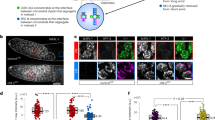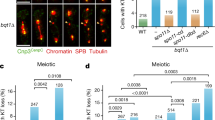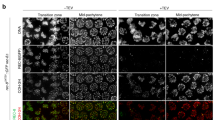Abstract
During meiosis, cohesins—protein complexes that hold sister chromatids together—are lost from chromosomes in a step-wise manner1. Loss of cohesins from chromosome arms is necessary for homologous chromosomes to segregate during meiosis I. Retention of cohesins around centromeres until meiosis II is required for the accurate segregation of sister chromatids. Here we show that phosphorylation of the cohesin subunit Rec8 contributes to step-wise cohesin removal. Our data further implicate two other key regulators of meiotic chromosome segregation, the cohesin protector Sgo1 and meiotic recombination in bringing about the step-wise loss of cohesins and thus the establishment of the meiotic chromosome segregation pattern. Understanding the interplay between these processes should provide insight into the events underlying meiotic chromosome mis-segregation, the leading cause of miscarriages and mental retardation in humans.
This is a preview of subscription content, access via your institution
Access options
Subscribe to this journal
Receive 51 print issues and online access
$199.00 per year
only $3.90 per issue
Buy this article
- Purchase on Springer Link
- Instant access to full article PDF
Prices may be subject to local taxes which are calculated during checkout




Similar content being viewed by others
References
Marston, A. L. & Amon, A. Meiosis: cell-cycle controls shuffle and deal. Nature Rev. Mol. Cell Biol. 5, 983–997 (2004)
Buonomo, S. B. et al. Division of the nucleolus and its release of Cdc14 during anaphase of meiosis I depends on Separase, Spo12, and Slk19. Dev. Cell 4, 727–739 (2003)
Tang, T. T., Bickel, S. E., Young, L. M. & Orr-Weaver, T. L. Maintenance of sister-chromatid cohesion at the centromere by the Drosophila MEI-S332 protein. Genes Dev. 12, 3843–3856 (1998)
Kerrebrock, A. W., Moore, D. P., Wu, J. S. & Orr-Weaver, T. L. MEI-S332, a Drosophila protein required for sister-chromatid cohesion, can localize to meiotic centromere regions. Cell 83, 247–256 (1995)
Katis, V. L., Galova, M., Rabitsch, K. P., Gregan, J. & Nasmyth, K. Maintenance of cohesin at centromeres after meiosis I in budding yeast requires a kinetochore-associated protein related to MEI-S332. Curr. Biol. 14, 560–572 (2004)
Kitajima, T. S., Kawashima, S. A. & Watanabe, Y. The conserved kinetochore protein Shugoshin protects centromeric cohesion during meiosis. Nature 427, 510–517 (2004)
Marston, A. L., Tham, W. H., Shah, H. & Amon, A. A genome-wide screen identifies genes required for centromeric cohesion. Science 303, 1367–1370 (2004)
Kiburz, B. M. et al. The core centromere and Sgo1 establish a 50-kb cohesin-protected domain around centromeres during meiosis I. Genes Dev. 19, 3017–3030 (2005)
Kitajima, T. S. et al. Shugoshin collaborates with protein phosphatase 2A to protect cohesin. Nature 441, 46–52 (2006)
Riedel, C. G. et al. Protein phosphatase 2A protects centromeric sister chromatid cohesion during meiosis I. Nature 441, 53–61 (2006)
Nasmyth, K. & Haering, C. H. The structure and function of SMC and kleisin complexes. Annu. Rev. Biochem. 74, 595–648 (2005)
Yu, H. G. & Koshland, D. Chromosome morphogenesis: Condensin-dependent cohesin removal during meiosis. Cell 123, 397–407 (2005)
Alexandru, G., Uhlmann, F., Mechtler, K., Poupart, M. A. & Nasmyth, K. Phosphorylation of the cohesin subunit Scc1 by Polo/Cdc5 kinase regulates sister chromatid separation in yeast. Cell 105, 459–472 (2001)
Lee, B. H. & Amon, A. Role of Polo-like kinase Cdc5 in programming meiosis I chromosome segregation. Science 300, 482–486 (2003)
Clyne, R. K. et al. Polo-like kinase Cdc5 promotes chiasmata formation and cosegregation of sister centromeres at meiosis I. Nature Cell Biol. 5, 480–485 (2003)
Hornig, N. C. & Uhlmann, F. Preferential cleavage of chromatin-bound cohesin after targeted phosphorylation by Polo-like kinase. EMBO J. 23, 3144–3153 (2004)
Klein, F. et al. A central role for cohesins in sister chromatid cohesion, formation of axial elements, and recombination during yeast meiosis. Cell 98, 91–103 (1999)
Buonomo, S. B. et al. Disjunction of homologous chromosomes in meiosis I depends on proteolytic cleavage of the meiotic cohesin Rec8 by Separase. Cell 103, 387–398 (2000)
Keeney, S., Giroux, C. N. & Kleckner, N. Meiosis-specific DNA double-strand breaks are catalyzed by Spo11, a member of a widely conserved protein family. Cell 88, 375–384 (1997)
Bergerat, A. et al. An atypical topoisomerase II from Archaea with implications for meiotic recombination. Nature 386, 414–417 (1997)
Toth, A. et al. Functional genomics identifies monopolin: A kinetochore protein required for segregation of homologs during meiosis I. Cell 103, 1155–1168 (2000)
Alani, E., Padmore, R. & Kleckner, N. Analysis of wild-type and rad50 mutants of yeast suggests an intimate relationship between meiotic chromosome synapsis and recombination. Cell 61, 419–436 (1990)
Bishop, D. K., Park, D., Xu, L. & Kleckner, N. Dmc1: A meiosis-specific yeast homolog of E. coli RecA required for recombination, synaptonemal complex formation, and cell cycle progression. Cell 69, 439–456 (1992)
Shonn, M. A., Murray, A. L. & Murray, A. W. Spindle checkpoint component Mad2 contributes to biorientation of homologous chromosomes. Curr. Biol. 13, 1979–1984 (2003)
Shonn, M. A., McCarroll, R. & Murray, A. W. Requirement of the spindle checkpoint for proper chromosome segregation in budding yeast meiosis. Science 289, 300–303 (2000)
Cohen-Fix, O., Peters, J. M., Kirschner, M. W. & Koshland, D. Anaphase initiation in Saccharomyces cerevisiae is controlled by the APC-dependent degradation of the anaphase inhibitor Pds1p. Genes Dev. 10, 3081–3093 (1996)
Nairz, K. & Klein, F. mre11S—a yeast mutation that blocks double-strand-break processing and permits nonhomologous synapsis in meiosis. Genes Dev. 11, 2272–2290 (1997)
Visintin, R. et al. The phosphatase Cdc14 triggers mitotic exit by reversal of CDK-dependent phosphorylation. Mol. Cell 2, 709–718 (1998)
Acknowledgements
We thank F. Lewitter for help with the Polo kinase substrate consensus sequence analysis, L.-S. Ee for technical assistance, K. Nasmyth and Y. Watanabe for communication of results before publication and B. Lee, A. Marston and members of the Amon Lab for input and critical reading of the manuscript. A.A. is an Investigator of the Howard Hughes Medical Institute. This research was supported by an NIH grant to A.A. and a NSF pre-doctoral fellowship to G.A.B. Author Contributions G.A.B., B.M.K. and A.A. participated in the design of experiments. G.A.B. and B.M.K. performed all non-MS experiments. Y.Z., J.-E.K. and F.W. designed and performed all MS analysis and analysed MS results.
Author information
Authors and Affiliations
Corresponding author
Ethics declarations
Competing interests
Reprints and permissions information is available at npg.nature.com/reprintsandpermissions. The authors declare no competing financial interests.
Supplementary information
Supplementary Figure 1
Example of a MS/MS spectrum. (PDF 29 kb)
Supplementary Figure 2
Coverage of the Rec8 in the various cell cycle arrest. (PDF 92 kb)
Supplementary Figure 3
Mutation of the phosphorylation sites in Rec8 to alanine interferes with progression through meiosis I. (PDF 66 kb)
Supplementary Figure 4
Mutations of phosphorylation or cleavage sites of Rec8 interferes with chromosome segregation. (PDF 38 kb)
Supplementary Figure 5
Metaphase I cells lacking Pds1 accumulate in rec8-17A mutants. (PDF 128 kb)
Supplementary Figure 6
Recombination allows Rec8 cleavage in rec8-17A and rec8-29A mutants. (PDF 135 kb)
Supplementary Figure 7
Rec8-17A cleavage in cells expressing a catalytically dead version of SPO11. (PDF 92 kb)
Supplementary Figure 8
Deletion of SPO11 abolishes step-wise loss of meiotic cohesion. (PDF 73 kb)
Supplementary Figure 9
Depletion of Sgo1 in spo11-Y135F, rad50S or dmc1Δ mek1Δ mutants allows proper meiosis II chromosome segregation in Sgo1-depleted cells. (PDF 27 kb)
Supplementary Figure 10
Depletion of Sgo1 partially alleviates the need for Rec8 phosphorylation and Cdc5 in Rec8 cleavage and anaphase I entry. (PDF 142 kb)
Supplementary Figure 11
Depletion of Sgo1 allows Rec8 removal from chromosomes in Cdc5-depleted cells. (PDF 832 kb)
Supplementary Figure 12
Rec8 phosphorylation on S136 and S521 is regulated during meiosis. (PDF 40 kb)
Supplementary Table 1
Cdc5 independent phosphorylation sites. (DOC 80 kb)
Supplementary Table 2
CDC5-dependent phosphorylation sites (PDF 43 kb)
Supplementary Notes
This file contains the Supplementary Methods, Supplementary Figure Legends, Supplementary Table 3 and additional references. (DOC 152 kb)
Rights and permissions
About this article
Cite this article
Brar, G., Kiburz, B., Zhang, Y. et al. Rec8 phosphorylation and recombination promote the step-wise loss of cohesins in meiosis. Nature 441, 532–536 (2006). https://doi.org/10.1038/nature04794
Received:
Accepted:
Published:
Issue Date:
DOI: https://doi.org/10.1038/nature04794
This article is cited by
-
HIGH CROSSOVER RATE1 encodes PROTEIN PHOSPHATASE X1 and restricts meiotic crossovers in Arabidopsis
Nature Plants (2021)
-
Meiotic prophase-like pathway for cleavage-independent removal of cohesin for chromosome morphogenesis
Current Genetics (2019)
-
An interplay between Shugoshin and Spo13 for centromeric cohesin protection and sister kinetochore mono-orientation during meiosis I in Saccharomyces cerevisiae
Current Genetics (2018)
-
Couples, pairs, and clusters: mechanisms and implications of centromere associations in meiosis
Chromosoma (2014)
-
Geometry and force behind kinetochore orientation: lessons from meiosis
Nature Reviews Molecular Cell Biology (2012)
Comments
By submitting a comment you agree to abide by our Terms and Community Guidelines. If you find something abusive or that does not comply with our terms or guidelines please flag it as inappropriate.



